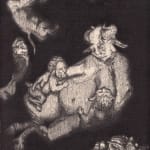

Installation view Hommage à Pan series at Husk Gallery
Peter Depelchin
The small series “Hommage à Pan” shows four different representations of the God Pan. Initially intended to illustrate the emergence and dissolvency of the God Pan out of and into the dark as described by Arthur Machen:
“Then I saw the body descend to the beasts whence it ascended, and that which was on the heights go down to the depths, even to the abyss of all being. The principle of life which makes organisms, always remained, while the outward form changed. (…) The light within the room turned to blackness, not the darkness of night, in which objects are seen dimly, for I could see clearly and without difficulty. But it was the negation of light; (…)”
Depelchin invites the spectator to discover the ancient principle of life represented by the God Pan, ascending from the blackness. According to Peter, each of the drawings of the series emphasizes another aspect of the principle of life and nature: light, movement, nurture, gravity. The first drawing shows a satyr emerging from the darkness, thus delivering light. The second drawing represents a dancing satyr and a planet, both in eternal movement. The principle of nurture is clearly represented in the third drawing: a female satyr nourishes two of her infants. The fourth drawing shows the same mysterious figure represented in the large drawing “The Great God Pan”, holding a ring and a feather; both self-proclaimed symbols of gravity according to Peter.
Finally, the name Depelchin granted to the series, refers to the gouache painting “Hommage à Pan” de Félicien Rops (1882, 30.5*21.5 cm, private collection) representing a woman embracing a Herma representing the God Pan emerging from the blackness. Not to mention the poem by Victor Hugo “le Satyre” (La Légende des siècles, Hetzel, 1859, première série) describing a hidden satyr, at last revealing his identity and his true power to the gods of Mount Olympus and crushing them. The poem is constructed as follows: Le satyre - le bleu - le noir - le sombre – l’étoile; all omnipresent in Depelchin’s latest body of works.
- X
- Tumblr





